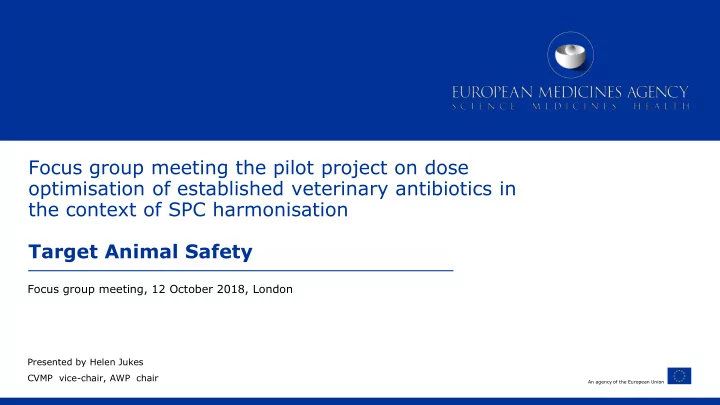

Focus group meeting the pilot project on dose optimisation of established veterinary antibiotics in the context of SPC harmonisation Target Animal Safety Focus group meeting, 12 October 2018, London Presented by Helen Jukes CVMP vice-chair, AWP chair An agency of the European Union
Approach for addressing risks to target animal safety due to changes in the dosing regimen Data available Proprietary TAS studies (VICH GL 43) • Proprietary clinical trials – field safety data (GCP) • Proprietary dose determination studies, non-target laboratory animal safety • studies Pharmacovigilance – PSURs • Published literature: Journals, FoI reports, grey literature • 1 Presentation title (to edit, click Insert> Header and Footer)
Underlying principles PK/PD increased dose ‘mg/kg’; duration of treatment generally unchanged • Increased dose reduced margin of safety (MOS) • Additional risk mitigation measures may be possible • Acceptable MOS depends on the ‘benefit - risk’ for the product • Data can be pooled from different products providing that differences in • formulation, pharmaceutical form and route of administration are taken into account 2 Presentation title (to edit, click View > Header and Footer)
Seven steps Progress through the steps until sufficient reassurance of the MOS for the new dose is obtained Step 1 : Review of classical TAS studies for products with same pharmaceutical form and route of administration Aim Confirm target organs and toxicity profile for the active substance • Estimate the MOS for the improved dose • Systemic, reproductive and local tolerance 3 Presentation title (to edit, click View > Header and Footer)
Step 2 : Safety in the target population - review of clinical/field studies for products with same pharmaceutical form and route of administration Safety in diseased animals • Evidence of sensitive sub-populations • Step 3 : Post-marketing pharmacovigilance Eudravigilance database • Step 4 (if needed): Published literature; Authorisations in 3 rd (VICH) countries; SPCs May also include general safety for the active substance • 4 Presentation title (to edit, click View > Header and Footer)
Step 5 : Conclude on the MOS for the increased dose for the pharmaceutical form and route of administration Step 6 : Product-specific considerations Excipients • Indications • Step 7 : Conclude on the benefit-risk for the dose increase for each specific product 5 Presentation title (to edit, click View > Header and Footer)
Findings from case study 1 Amoxicillin in drinking water for treatment of SRD (dose doubled from 10-20 mg/kg/d to 40 mg/kg/d) AEs: Hypersensitivity. Gastrointestinal disturbances (microbiota). Rarely hepato- and renal toxicity. Simple excipient formulations. Available proprietary studies not to current GLP standards but, coupled with published and grey literature, sufficient evidence to support safety of the dose increase. 6 Presentation title (to edit, click View > Header and Footer)
Findings from case study 2 Oxytetracycline injections to treat BRD (dose remained within the original range of possible doses, but for some 10% formulations there would be an increase; for some 20% formulations the requirement for a 2 nd injection at 36-48 h is new) AEs: Renal toxicity, lower MOS TAS studies showed that OTC local injection site reactions restrict the injection volume according to the formulation (SPC directions to be followed) 7 Presentation title (to edit, click View > Header and Footer)
Thank you for your attention Further information zoltan.kunsagi@ema.europa.eu European Medicines Agency 30 Churchill Place • Canary Wharf • London E14 5EU • United Kingdom Telephone +44 (0)20 3660 6000 Facsimile +44 (0)20 3660 5555 Send a question via our website www.ema.europa.eu/contact Follow us on @EMA_News
Recommend
More recommend